2. 重庆市农业资源与环境研究重点实验室, 重庆 400716
2. Chongqing Key Laboratory of Agricultural Resources and Environment, Chongqing 400716, China
磷素作为水生生物的主要营养物质,被认为是水体富营养化的限制性营养元素[1]. 按照水体磷形态分析可知,磷素形态可分为:颗粒态磷、 溶解性正磷酸盐、 无机聚磷酸盐、 溶解性有机磷等[2]. 自然水体是高度的异质性分散体系,水体中不同形态磷的分级并不相同,例如,通常>0.45 μm磷被界定为颗粒态磷,<0.45 μm磷被定义为溶解态磷,部分溶解态磷以胶体态存在[3],另有部分溶解性有机磷相对分子质量大于5×103[4],而溶解性正磷酸盐的部分可用<0.5×103的组分表示[5]. 目前,已有大量学者通过超滤、 透析、 离子树脂和凝胶色谱排阻法等手段在土壤和水体系统中按水体相对分子质量的不同对磷素进行研究[6, 7, 8],发现水体不同相对分子质量组分中磷的环境化学行为有较大差异[9],高相对分子质量组分的磷生物有效性在短时间内会降低,而从长时间范围看则可能成为潜在的磷释放风险源,低相对分子质量组分的磷酸盐则能直接被生物所利用. 由此可见,了解磷在水体不同相对分子质量组分中的分布有助于进一步认识磷素在富营养化形成过程中的重要作用.
紫外线作为太阳光中的重要组成部分,对水生生态系统(如河流和海洋)中元素的迁移转化有着重要影响[10,11]. 对磷素而言,紫外光照对其影响主要有以下两个方面:①紫外光照对微生物、 植物等生物活性的影响,间接影响生物对磷素的吸收[12]; ②紫外光照对有机磷化合物(如有机磷农药,杀虫剂等[13,14])和光敏磷化合物的直接光降解过程[15,16]. 综上,紫外光照对环境中磷素的迁移转化过程的影响不可忽视.
水体交汇处是环境变化的敏感区域之一,对于入海和入湖交汇处污染物迁移转化已有较多研究[17,18],尤其是河口环境. 而有关淡水河流交汇处污染物,特别是营养元素(如磷)形态特征的关注尚不多见[19]. 嘉陵江流域内营养元素随水土流失严重,人类活动和牲畜排泄等向水体中排放大量的磷[20],导致水体营养盐浓度较高. 以往有关流域内磷素的研究主要从污染来源和污染负荷等角度进行讨论[21, 22, 23],研究重点着眼于水体中总磷和生物有效磷的讨论. 因此,本研究以渠江-嘉陵江、 涪江-嘉陵江交汇处水体为对象,探讨了河流交汇处水体磷素的形态特征,水体不同相对分子质量组分中磷的分布特征及紫外光照的影响. 研究结果对深入了解水体交汇处磷素的地球化学过程和富营养化防治提供一定的科学依据. 同时,渠江、 涪江和嘉陵江水体作为长江上游重要水体,也是合川当地重要的饮水源,对保护饮用水安全和改善水环境质量也能提供一定的理论基础. 1 材料与方法 1.1 样品采集
嘉陵江干流全长1156 km,全流域集水面积约16 万km2,是长江水系流域面积最大的一条支流,而涪江和渠江是嘉陵江最大的两条支流,前者下游土地开垦率高、 森林覆盖率低,水土流失较严重,后者是沟通内地物资交往的主要通道,含沙量较大,流域内渔业较发达,下游沿岸以农耕地为主. 渠江和涪江均于重庆市合川区汇入嘉陵江,渠江-嘉陵江汇合处距涪江-嘉陵江汇合处8 km左右,前者汇合处位于郊区,沿岸土地利用类型以林地为主,后者汇合处位于城区码头,文峰古街旁,受人为影响大.
2013年6月于渠江-嘉陵江、 涪江-嘉陵江交汇前后0.5~1 km内、 交汇处的两岸和中心分别采集表层水样(0~50 cm)并混合,具体采样点如下(图 1):涪江交汇前(F)、 涪江-嘉陵江交汇处(J-F)、 涪江-嘉陵江交汇后(J-1)、 涪江-嘉陵江交汇前(J-2)、 渠江-嘉陵江交汇后(J-3)、 渠江-嘉陵江交汇处(J-Q)、 渠江交汇前(Q)、 渠江-嘉陵江交汇前(J-4). 水样采集后,现场采用多参数水质测定仪(HANNA,HI98130)测定pH等指标,随后样品立即放入4℃保温箱内,当天送回实验室.
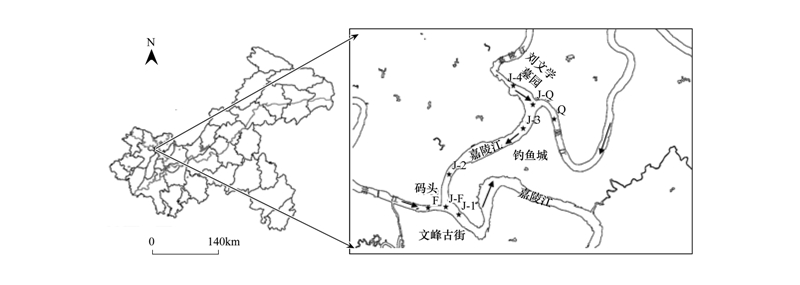 | 图 1 采样点位置分布示意 Fig. 1 Distribution of sample sites 箭头代表水流方向 |
水样运回实验室后,未过滤样品24 h内测定总磷(TP)、 总铁(TFe),水样过0.45 μm滤膜后测定溶解性有机质(DOM)、 溶解性总铁(TDFe)、 总溶解性磷(TDP)、 溶解性无机磷(DIP),通过差减法得到颗粒态磷(PP)和溶解性有机磷(DOP)的含量:PP=TP-TDP,DOP=TDP-DIP,水体基本性质见表 1. DOM浓度采用GE TOC分析仪测定,以溶解性有机碳(DOC)表示,单位mg ·L-1. 其他指标测定方法参照文献[24].
|
|
表 1 水样的基本性质 Table 1 Basic properties of water samples |
避免微生物的影响,水样过0.22 μm滤膜后按不同相对分子质量进行超滤分级(图 2),同时测定过膜后滤液中溶解性磷(DP)浓度,参照Guardado等[25]的方法,测定通过不同相对分子质量超滤膜(10×103、 0.5×103)的滤液中磷含量,Mr 10×103~0.22 μm、 0.5×103~10×103和<0.5×103部分分别代表胶体态、 溶解态大分子组分和溶解态小分子组分(以游离态为主,以下简称游离态组分)[5,26],实验过程中以铝箔纸包裹超滤装置,避免光照影响. 超滤分级采用MSC300型直流正向超滤杯进行,超滤实验回收率在95%~105%[27].
 | 图 2 超滤分级步骤 Fig. 2 Steps of ultrafiltration |
取过0.22 μm滤膜后水样装入玻璃烧杯中,然后放入自制的UV光照实验模拟箱中(图 3),光源为UVA,光照强度为500 μW ·cm-2,光照时间为10 h. 光照结束后,按1.3节所述方法测定不同相对分子质量组分的磷含量. 数据分析采用Orgin 8.5和SPSS 17.0进行.
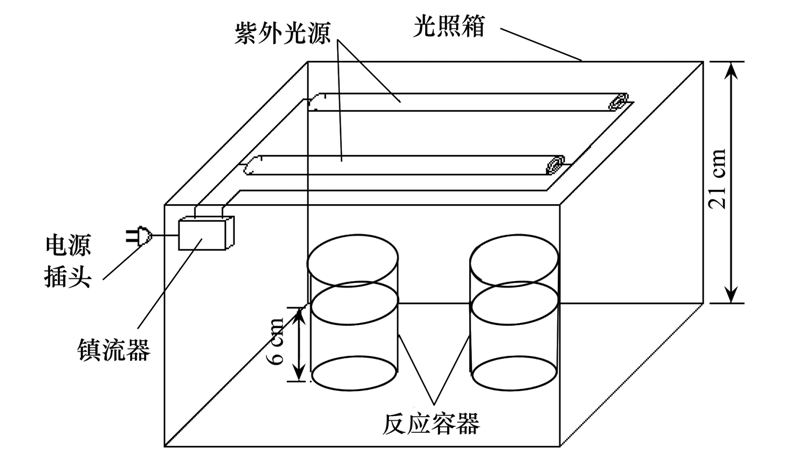 | 图 3 模拟紫外光照示意 Fig. 3 Skech map of simulated UV irradiation |
水体磷形态测定结果如图 4,各采样点水体TP浓度均超过水体富营养化的阈值(0.2 mmol ·m-3)[28],水体中磷形态以TDP为主,占TP含量的60%~75%,其中DIP为 TDP 的主要成分,占TDP含量的80%~90%. 渠江与涪江汇入嘉陵江前,除DOP外,水体中TP、 PP、 TDP、 DIP浓度均高于汇合前干流值. 渠江与涪江汇入嘉陵江后,干流水体TP、 PP、 TDP、 DIP、 DOP浓度均高于干流汇合前值,分别增加41%、 129%、 12%、 12%、 10%,但TDP仍为TP的主要成分. 嘉陵江下游人口密集,污染较重,且涪江和渠江为嘉陵江水体氮磷负荷贡献最大的两条支流[29],尤其是涪江汇入嘉陵江前,流经人口密集的合川城区,可能是涪江与干流交汇处水体总磷浓度较高,涪江汇合前水体总磷浓度最高的主要原因. 水生生态系统中,DIP 被认为是水生生物可直接利用的磷素形态[30],本研究中,各采样点水体DIP占TP含量的47%~60%,表明研究水体中磷的生物有效性较高. 两支流水体相对较浑浊,泥沙含量高[31],可能是两支流汇入嘉陵江后,干流水体PP含量增加的主要原因,在干流的自净作用下,其它各形态磷浓度也略有增加.
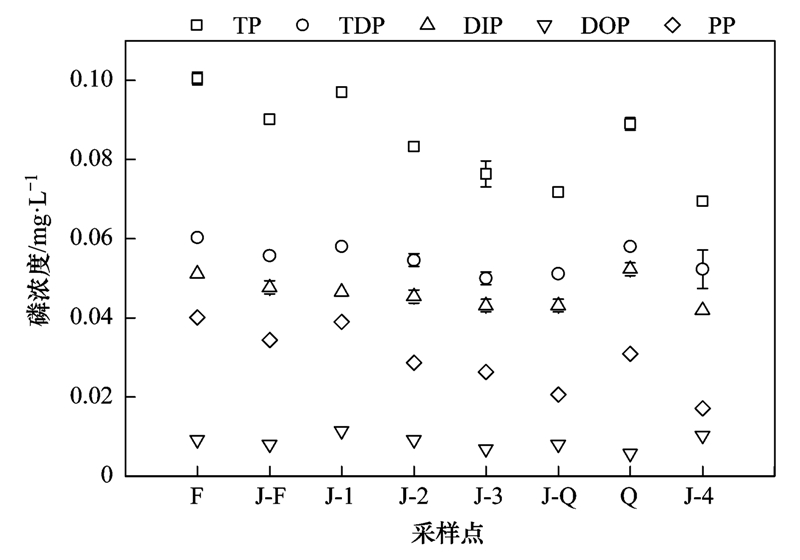 | 图 4 水体中各形态磷浓度 Fig. 4 Phosphorus concentration of different forms in water samples |
和传统对磷形态的讨论不同,本研究还结合了水体中不同相对分子质量组分,进一步分析了河流交汇处水体中不同相对分子质量组分的磷分布特征. 结果发现,DP与TDP浓度差异很小,表明>0.22 μm滤膜上的那部分磷可忽略不计. 各采样点水体不同相对分子质量组分中磷的分布如图 5,0.5×103~10×103组分的磷为DP的主要成分,占到47%~61%,除汇合前渠江水体,其余各采样点水体中 Mr 10×103~0.22 μm组分的磷占DP含量均大于<0.5×103组分的磷,且渠江和涪江两支流汇入干流后,嘉陵江水体不同相对分子质量组分的磷含量并未发生较大变化. 结果表明,游离态磷酸盐并非水体DP的主要成分,这和一些研究结果类似[32, 33],且报道称相对分子质量<0.5×103组分的磷可表征水体中溶解性正磷酸盐的含量[5],但2.1节中水体磷形态分析结果显示,水体中DIP为各采样点水体中磷的主要形态,两者测得的值相差较大(图 6),究其原因,可能是采用钼蓝法测定时,高相对分子质量组分的溶解性有机磷水解,导致DIP含量偏高[34,35]. 另外,溶解态和胶体态组分的磷为研究水体磷素的主要赋存形式,其来源可能主要有两个方面:①水体中核酸DNA部分[8]、 磷脂单酯[36]或肌醇磷脂[37]等有机大分子磷物质; ②溶解性有机质(DOM)-金属-磷(P)复合物类物质(例如DOM-Fe-P)[38,39],由于DOM成分复杂,以腐殖质为主,可占总有机质的40%~80%[40],且其相对分子质量分布较广[41],胡敏酸相对分子质量在几千到几百万,富里酸相对分子质量在几百到几千[42],可使复合物相对分子质量处于不同级别. 同时,通过对样品DOM的地化特征分析,其陆源输入特征明显. 因此,推测水体中胡敏酸、 富里酸与磷和金属(如Fe)形成的复合物可能是胶体态和溶解态大分子组分中磷的主要成分.
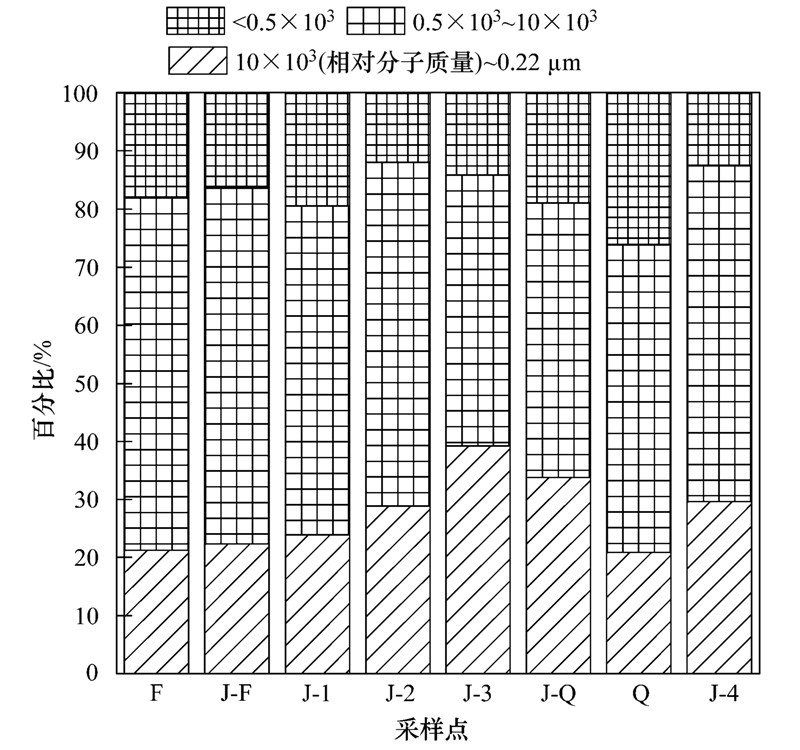 | 图 5 不同相对分子质量组分的磷占DP的质量分数 Fig. 5 Percentages of different molecule weights phosphorus in DP |
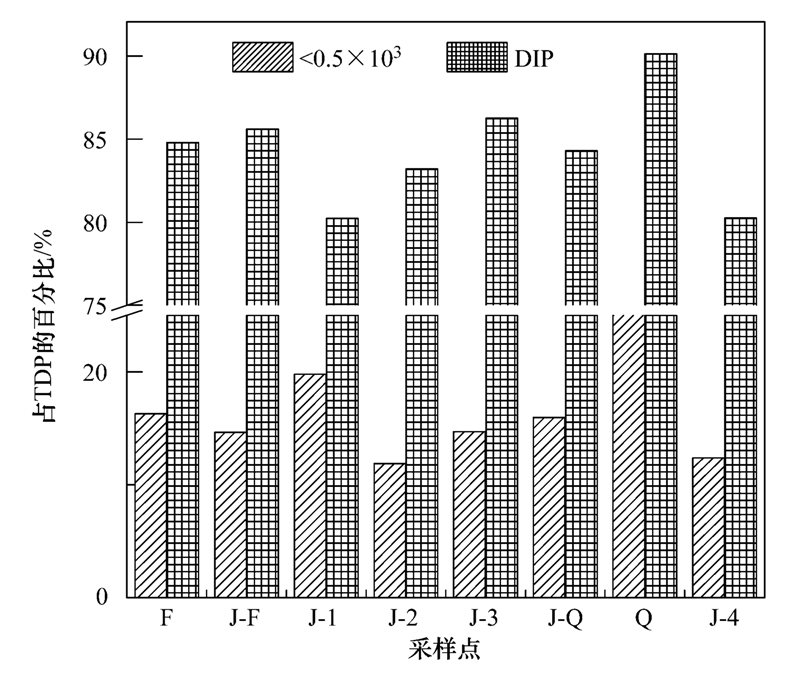 | 图 6 DIP和游离态磷占TDP的质量分数 Fig. 6 Percentages of TDP and free form phosphate in DP |
各采样点水体经紫外光照射后,不同相对分子质量组分的磷占DP的质量分数如图 7,与光照前(图 5)对比发现,各采样点水体DP中<0.5×103 组分的磷含量明显增加,增幅在10%~29%,Mr 10×103~0.22 μm和0.5×103~10×103两组分中磷含量均降低,降幅分别在2%~13%和9%~17%,其中,涪江-嘉陵江汇合处水体中Mr 10×103~0.22 μm组分的磷含量降幅仅为2%~6%,而渠江-嘉陵江汇合处水体中Mr 10×103~0.22 μm组分的磷含量降幅达到10%~13%. 由此可以证明,紫外光照是影响水体中磷素地球化学过程的重要环境因素.
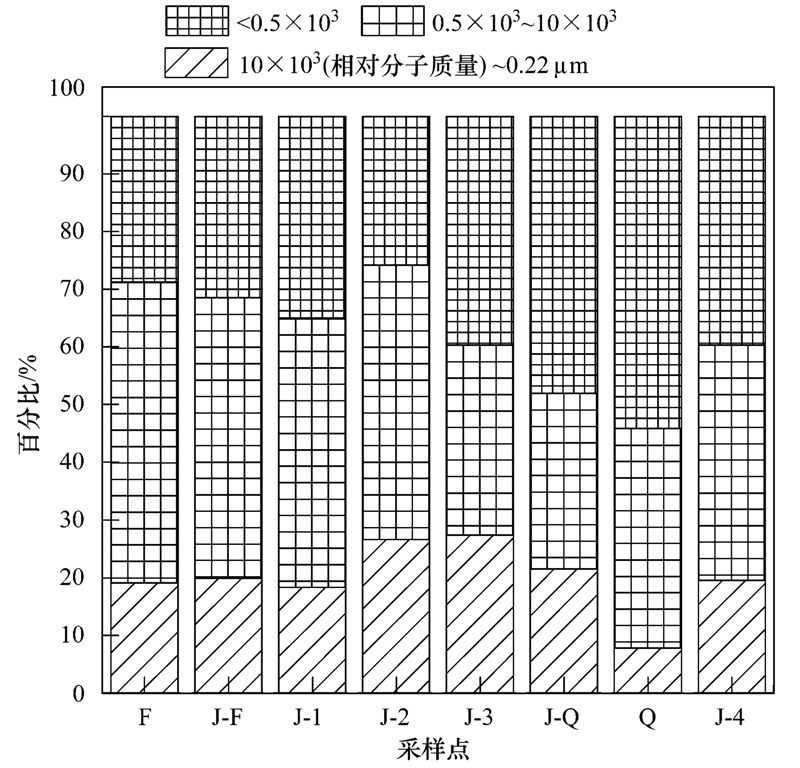 | 图 7 紫外光照后,不同相对分子质量组分中磷占DP的质量分数 Fig. 7 Percentages of different molecule weights phosphorus in DP after UV irradiation |
水体中存在光敏感的DOM-金属-P复合物体系,其光降解过程可能是解释以上实验现象的重要原因. 首先,紫外光照下,DOM将发生光降解过程,导致其与金属的结合强度降低[43,44]; 其次,光照是 控制环境中铁形态的重要因素之一,光引发的电子 转移可直接导致Fe(Ⅲ)还原为Fe(Ⅱ)[45],而Fe(Ⅲ)是形成DOM-金属-P复合物的重要金属离子[46],报道称Fe(Ⅲ)-DOM复合物能结合磷,而Fe(Ⅱ)-DOM复合物则不能[47],另一方面,紫外光照下,水体中水合氧化铁结合的正磷酸盐可能发生光溶解,促使磷酸盐的释放[48];最后,DOM可加速天然水体中光-Fenton反应过程[49,50],导致Fe(Ⅲ)向Fe(Ⅱ)还原,进而导致复合物的光降解. 研究还发现,渠江与干流汇合处水体DOM的芳香度和相对分子质量均大于涪江与干流汇合处水体,这将导致两者水体光化学反应活性不同. 一般而言,紫外光照下,芳香性高、相对分子质量大的DOM组分紫外吸收更强,更易发生光降解过程[51],进而使水体中DOM-金属-P复合物的降解更剧烈,这可能是两支流与干流交汇处水体中胶体态组分的磷含量降解幅度存在差异的主要原因.
此外,有文献报道了湖泊水体、 土壤溶液等系统也存在类似的观测现象(详见表 2),在短时间低剂量的紫外光照下,部分湖泊水体中高相对分子质量组分的磷降解率远大于本研究实验结果,笔者推测这与实验所用的水体类型有着直接的联系. 文献中研究水体多为湖泊水体且呈富营养化状态,部分水体为腐殖质沼泽水体,或者“褐水”,腐殖质和磷含量均较高,在金属离子共存下,大量的磷以DOM-金属-P复合物形式存在. 紫外光照射下,由于DOM介导的光化学反应过程明显,使得大量水体高相对分子质量组分的磷发生光降解,导致磷素得以释放. 本研究中,水样采自河流交汇处,水体中DOM含量远低于文献报道的水体,腐殖化程度较低,其结构复杂程度也远低于文献中DOM.
|
|
表 2 与文献报道结果对比 Table 2 Comparing results from references with this study |
(1)研究的所有水体中总磷浓度均超过水体富营养化阈值,渠江、 涪江为嘉陵江水体带来了浓度相对较高的磷素,同时两支流水体含沙量较大,在交汇处可能为污染物提供了反应界面,加之交汇处水流速度减缓,两支流与干流交汇处水体富营养化风险相对较大.
(2)研究水体中0.5×103~10×103组分的磷为DP的主要组成部分,占到47%~61%,而可代表能被生物直接利用的水体游离态磷酸盐组分(<0.5×103)含量较低,渠江、 涪江汇入嘉陵江后,干流水体中不同相对分子质量组分的磷占DP质量分数并未发生较大变化. 紫外光照射后,各采样点水体中<0.5×103组分的磷含量明显增加,增幅在10%~29%,而其余两个组分的磷含量均降低. 可知,紫外光照下,有利于水体生物可利用磷含量的增加,表明紫外光照是影响水体中磷素地球化学过程的重要环境因素.
致谢: 本研究在作图过程中得到西南大学资源环境学院环境科学与工程系研究生赵铮和郭喜丰的帮助,在此表示衷心的感谢.
| [1] | Mainstone C P, Parr W. Phosphorus in rivers-ecology and management[J]. Science of the Total Environment, 2002, 282-283: 25-47. |
| [2] | Holtan H, Kamp-Nielsen L, Stuanes A O. Phosphorus in soil, water and sediment: an overview[J]. Hydrobiologia, 1988, 170 (1): 19-34. |
| [3] | Koenings J P, Hooper F F. The influence of colloidal organic matter on iron and iron-phosphorus cycling in an acid bog lake[J]. Limnology and Oceanography, 1976, 21 (5): 684-696. |
| [4] | White E, Payne G. Distribution and biological availability of reactive high molecular weight phosphorus in natural waters in New Zealand[J]. Canadian Journal of Fisheries and Aquatic Sciences, 1980, 37 (4): 664-669. |
| [5] | Broberg O, Persson G. Particulate and dissolved phosphorus forms in freshwater: composition and analysis[J]. Hydrobiologia, 1988, 170 (1): 61-90. |
| [6] | Guardado I, Urrutia O, Garcia-Minna J M. Some structural and electronic features of the interaction of phosphate with metal-humic complexes[J]. Journal of Agricultural and Food Chemistry, 2008, 56 (3): 1035-1042. |
| [7] | Gerke J, Jungk A. Separation of phosphorus bound to organic matrices在· from inorganic phosphorus in alkaline soil extracts by ultrafiltration[J]. Soil Science and Plant Analysis, 1991, 22 (15-16): 1621-1630. |
| [8] | Minear R A. Characterization of naturally occurring dissolved organophosphorus compounds[J]. Environmental Science and Technology, 1972, 6 (5): 431-437. |
| [9] | Shaw P J. The effect of pH, dissolved humic substances, and ionic composition on the transfer of iron and phosphate to particulate size fractions in epilimnetic lake water[J]. Limnology and Oceanography, 1994, 39 (7): 1734-1743. |
| [10] | Abrevaya X C, Hanslmeier A, Leitzinger M, et al. UV radiation of the young sun and its implications for life in the solar system[J]. Central European Astrophysical Bulletin, 2013, 37: 649-654. |
| [11] | Imoberdorf G, Mohseni M. Degradation of natural organic matter in surface water using vacuum-UV irradiation[J]. Journal of Hazardous Materials, 2011, 186 (1): 240-246. |
| [12] | Jiang X, Jin X C, Yao Y, et al. Effects of biological activity, light, temperature and oxygen on phosphorus release processes at the sediment and water interface of Taihu Lake, China[J]. Water Research, 2008, 42 (8-9): 2251-2259. |
| [13] | Shayeghi M, Dehghani M H, Alimohammadi M, et al. Using ultraviolet irradiation for removal of malathion pesticide in water[J]. Iranian Journal of Arthropod-Borne Diseases, 2012, 6 (1): 45-53. |
| [14] | Wu C L, Linden K G. Phototransformation of selected organophosphorus pesticides: Roles of hydroxyl and carbonate radicals[J]. Water Research, 2010, 44 (12): 3585-3594. |
| [15] | 刘华丽, 周易勇, 李建秋, 等. 东湖紫外光敏感磷与可酶解磷的分布及其相互关系[J]. 武汉大学学报(理学版), 2002, 48 (6): 705-708. |
| [16] | Jones R I, Salonen K, de Haan H. Phosphorus transformations in the epilimnion of humic lakes: abiotic interactions between dissolved humic materials and phosphate[J]. Freshwater Biology, 1998, 19 (3): 357-369. |
| [17] | van der Zee C, Roevros N, Chou L. Phosphorus speciation, transformation and retention in the Scheldt estuary (Belgium/The Netherlands) from the freshwater tidal limits to the North Sea[J]. Marine Chemistry, 2007, 106 (1-2): 76-91. |
| [18] | Jin X D, He Y L, Kirumba G, et al. Phosphorus fractions and phosphate sorption-release characteristics of the sediment in the Yangtze River estuary reservoir[J]. Ecological Engineering, 2013, 55: 62-66. |
| [19] | Uncles R J, Howland R J M, Easton A E, et al. Concentrations of dissolved nutrients in the tidal Yorkshire Ouse River and Humber Estuary[J]. Science of the Total Environment, 1998, 210-211: 377-388. |
| [20] | Wu L, Long T Y, Liu X, et al. Impacts of climate and land-use changes on the migration of non-point source nitrogen and phosphorus during rainfall-runoff in the Jialing River Watershed, China[J]. Journal of Hydrology, 2012, 475: 26-41. |
| [21] | 丁晓雯, 沈珍瑶. 涪江流域农业非点源污染空间分布及污染源识别[J]. 环境科学, 2012, 33 (11): 4025-4032. |
| [22] | 龙天渝, 李继承, 刘腊美. 嘉陵江流域吸附态非点源污染负荷研究[J]. 环境科学, 2008, 29 (7): 1811-1817. |
| [23] | Shen Z Y, Hong Q, Chu Z, et al. A framework for priority non-point source area identification and load estimation integrated with APPI and PLOAD model in Fujiang Watershed, China[J]. Agricultural Water Management, 2011, 98 (6): 977-989. |
| [24] | 国家环境保护总局. 水和废水监测分析方法[M]. (第四版). 北京: 中国环境科学出版社, 2002. |
| [25] | Guardado I, Urrutia O, Garcia-Mina J M. Size distribution, complexing capacity, and stability of phosphate-metal-humic complexes[J]. Journal of Agricultural and Food Chemistry, 2007, 55 (2): 408-413. |
| [26] | Sharma P, Ofner J, Kappler A. Formation of binary and ternary colloids and dissolved complexes of organic matter, Fe and As[J]. Environmental Science and Technology, 2010, 44 (12): 4479-4485. |
| [27] | Ged E C, Boyer T H. Molecular weight distribution of phosphorus fraction of aquatic dissolved organic matter[J]. Chemosphere, 2013, 91 (7): 921-927. |
| [28] | Bock M T, Miller B S, Bowman A W. Assessment of eutrophication in the Firth of Clyde: Analysis of coastal water data from 1982 to 1996[J]. Marine Pollution Bulletin, 1999, 38 (3): 222-231. |
| [29] | 李继承. 嘉陵江流域非点源污染负荷模拟研究[D]. 重庆: 重庆大学, 2007. |
| [30] | Hudson J J, Taylor W D. Measuring regeneration of dissolved phosphorus in planktonic communities[J]. Limnology and Oceanography, 1996, 41 (7): 1560-1565. |
| [31] | 邹强, 崔鹏, 张建强, 等. 长江上游地区泥石流灾害敏感性量化评价研究[J]. 环境科学与技术, 2012, 35 (3): 159-163, 167. |
| [32] | 高光, 朱广伟, 秦伯强, 等. 太湖水体中碱性磷酸酶的活性及磷的矿化速率[J]. 中国科学(D辑), 2005, 35 (增刊Ⅱ): 157-165. |
| [33] | Sereda J M, Hudson J J, Taylor W D. Abiotic effects of UV on planktonic P kinetics[J]. Aquatic Science, 2009, 71 (2): 127-134. |
| [34] | Gerke J. Humic (Organic Matter)-Al(Fe)-phosphate complexes: an underestimated phosphate form in soils and source of plant-available phosphate[J]. Soil Science, 2010, 175 (9): 417-425. |
| [35] | Rigler F H. Further observations inconsistent with the hypothesis that the molybdenum blue method measures orthophosphate in lake water[J]. Limnology and Oceanography, 1968, 13 (1): 7-13. |
| [36] | Francko D A. Relationships between phosphorus functional classes and alkaline phosphatase activity in reservoir lakes[J]. Journal of Freshwater Ecology, 1984, 2 (6): 541-547. |
| [37] | Turner B L, Paphazy M J, Haygarth P M, et al. Inositol phosphates in the environment[J]. Philosophical Transactions of the Royal Society of London Series B-biological Sciences, 2002, 357 (1420): 449-469. |
| [38] | Shaw P J, Jones R I, de Haan H. The influence of humic substances on the molecular weight distributions of phosphate and iron in epilimnetic lake waters[J]. Freshwater Biology, 2000, 45 (4): 383-393. |
| [39] | Gerke J. Phosphate adsorption by humic/Fe-oxide mixtures aged at pH 4 and 7 and by poorly ordered Fe-oxide[J]. Geoderma, 1993, 59 (1-4): 279-288. |
| [40] | Kitis M, Kilduff J E, Karanfil T. Isolation of dissolved organic matter (DOM) from surface waters using reverse osmosis and its impact on the reactivity of DOM to formation and speciation of disinfection by-products[J]. Water Research, 2001, 35 (9): 2225-2234. |
| [41] | 吴丰昌, 王立英, 黎文, 等. 天然有机质及其在地表环境中的重要性[J]. 湖泊科学, 2008, 20 (1): 1-12. |
| [42] | Thurman E M, Wershaw R L, Malcolm R L, et al. Molecular size of aquatic humic substances[J]. Organic Geochemistry, 1982, 4 (1): 27-35. |
| [43] | Hernes P J, Benner R. Transport and diagenesis of dissolved and particulate terrigenous organic matter in the North Pacific Ocean[J]. Deep Sea Research Part Ⅰ: Oceanographic Research Papers, 2002, 49 (12): 2119-2132. |
| [44] | Gao H Z, Zepp R G. Factors Influencing photoreactions of dissolved organic matter in a coastal river of the southeastern United States[J]. Environmental Science and Technology, 1998, 32 (19): 2940-2946. |
| [45] | Song W J, Ma W H, Ma J H, et al. Photochemical oscillation of Fe(Ⅱ)/Fe(Ⅲ) ratio induced by periodic flux of dissolved organic matter[J]. Environmental Science and Technology, 2005, 39 (9): 3121-3127. |
| [46] | Levesque M, Schnitzer M. Organic-metallic interactions in soils: 6.Preparation and properties of fulvic acid-metal phosphates[J]. Soil Science, 1967, 103 (3): 183-190. |
| [47] | Francko D A. Epilimnetic phosphorus cycling: influence of humic materials and iron on coexisting major mechanisms[J]. Canadian Journal of Fisheries and Aquatic Sciences, 1986, 43 (2): 302-310. |
| [48] | Estapa M L, Mayer L M, Boss E. Rate and apparent quantum yield of photodissolution of sedimentary organic matter[J]. Limnology and Oceanography, 2012, 57 (6): 1743-1756. |
| [49] | Voelker B M, Morel F M M, Sulzberger B. Iron redox cycling in surface waters: Effects of humic substances and light[J]. Environmental Science and Technology, 1997, 31 (4): 1004-1011. |
| [50] | Reina A C, Santos-Juanes L, Garcia S J L, et al. Modelling photo-Fenton process for organic matter mineralization, hydrogen peroxide consumption and dissolved oxygen evolution[J]. Applied Catalysis B: Environmental, 2012, 119-120: 132-138. |
| [51] | Dahlen J, Bertilsson S, Pettersson C. Effects of UV-A irradiation on dissolved organic matter in humic surface waters[J]. Environment International, 1996, 22 (5): 501-506. |
| [52] | Francko D A, Heath R T. Functionally distinct classes of complex phosphorus compounds in lake water[J]. Limnology and Oceanography, 1979, 24 (3): 463-473. |
| [53] | Francko D A, Heath R T. UV-sensitive complex phosphorus: Association with dissolved humic material and iron in a bog lake[J]. Limnology and Oceanography, 1982, 27 (3): 564-569. |
| [54] | Cotner J B Jr, Heath R T. Iron redox effects on photosensitive phosphorus release from dissolved humic materials[J]. Limnology and Oceanography, 1990, 35 (5): 1175-1181. |
| [55] | Hens M, Merckx R. Functional characterization of colloidal phosphorus species in the soil solution of sandy soils[J]. Environmental Science and Technology, 2001, 35 (3): 493-500. |
| [56] | Pant H K, Warman P R. Phosphorus release from soils upon exposure to ultra-violet light[J]. Communications in Soil Science and Plant Analysis, 2000, 31 (3-4): 321-329. |
| [57] | Navarro M B, Modenutti B. UVR induce optical changes and phosphorous release of lake water and macrophyte leachates in shallow Andean lakes[J]. Journal of Limnology, 2010, 69 (1): 112-119. |
 2014, Vol. 35
2014, Vol. 35


